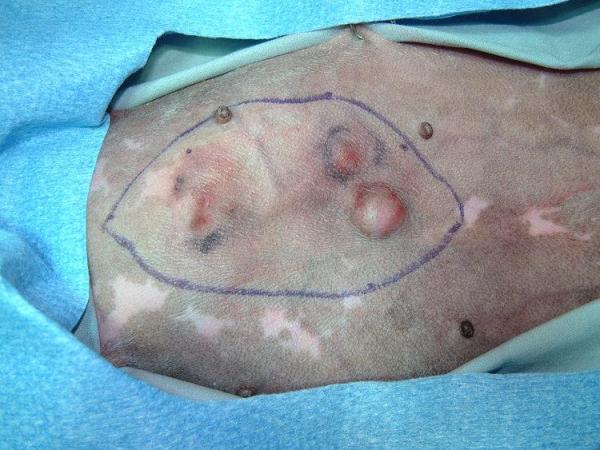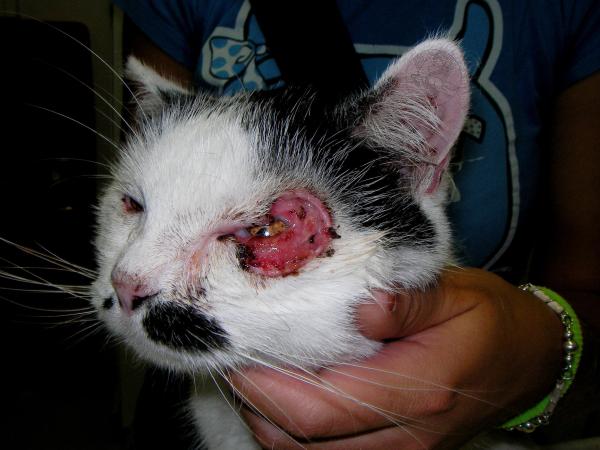My Elderly Cat Has a Tumor - Diagnosis and Treatment



See files for Cats
Being concerned that your elderly cat has a tumor is understandable. Unfortunately, as our cat's age, their immune response goes down and their chances of developing certain diseases go up. Tumors are one such health issue which increases in likelihood for older cats. Not all tumors will be malign or cancerous. Some may be benign and your cat can live without having their quality of life depleted significantly. Determining the cause and status of the tumor is essential if we want to ensure the cat has the best possible chance of living longer.
In this article, AnimalWised looks into the diagnosis and treatment of tumors in elderly cats. It's important to know there are different causes of tumors, even in senior cats. While we need to be extra-careful, it doesn't mean we can't offer some help.
What is a tumor?
As we have already mentioned, not all tumors are caused by cancer. Essentially, a tumor is an excessive growth of tissue anywhere in or on the body. This growth is caused by an inordinate reproduction of cells which we refer to as a neoplasm. The process of this growth is called neoplasia and the resultant tumor can be either benign or malign:
- Benign neoplasm: this generally has an organized and slow rate of growth. Usually the borders of the neoplasia are well defined and do not spread out to other parts of the body This spreading process is known as metastases.
- Malign neoplasm: malign neoplasms are cancerous. The cell grows relatively quickly and does so in a disorganized way. They have the ability to metastasize and spread, something which can be fatal if it spreads too far in the body. As the quickness of the growth is a factor, timing is important.
If we observe a tumor in our elderly cat, it is important to know what kind of tumor it is. This will be done with the help of laboratory tests, something which will require professional veterinary consultation. Talk to your vet right away so we can determine if it is malign or benign. Only then can the appropriate treatment be implemented.
Cancer in elderly cats
There are many different types of cancers that can affect older cats (an elderly cat is generally considered one over 10 years of age). The different causes of the cancer are also varied. For example, mammary gland cancer is usually associated with very high hormonal values, something more common in unsterilized cats. Similarly, a cat which has had an ovariohysterectomy will be unable to develop uterine cancer since they no longer have a uterus.
Older cats have weathered the years and their body becomes weaker as they age. This makes them more prone to certain types of cancer as their immune system is also weakened. In this article we focus on the three most common types of tumor in cats: mammary gland tumors, lymphoma, and squamous cell carcinoma.
Mammary gland tumors in cats
Mammary gland or breast tumors are the most common type of tumor in elderly cats. The average age at which this tumor develops is between 10 and 12 years of age. Not all mammary gland tumors in cats are malign, but it is estimated to be about 85% of cases. Even benign tumors may be surgically removed if they pose a risk of developing into cancer.
Although much more rare, it is possible for male cats to develop breast cancer. It is much more likely to appear in female cats, especially those which have not been spayed. If you notice a tumor in the cat's belly area, it is most likely a mammary gland tumor.
Causes of mammary gland tumors in cats
There are still no certainties of the direct cause of mammary gland cancer in cats. However, there are some specific risk factors we should be aware of. Some studies show that Siamese cats are at an increased risk of developing mammary carcinomas[1]. However, due to sheer population size, Domestic Shorthair cats are the most likely to develop the disease in general.
Tumors of the mammary gland are much less common in sterilized cats. Additionally, the age at which the cat is sterilized may decrease the risk of these types of tumors. One study found that cats sterilized at less than 6 months of age have a 91% less chance of developing breast cancer, while cats sterilized less than 1 year of age have a risk reduced by 86%[2]. Cats suffering obesity are also more likely to develop this type of cancer in cats,
Another risk factor is due to the alternative methods of sterilization in cats. Contraceptive pills and injections have been shown to increase the risk of certain cancers in cats. This is why we highly recommend avoiding these types of injections in cats.
Symptoms of mammary gland tumors in cats
The majority of the time, this type of feline tumor is detected by a veterinarian during a consultation or checkup. Especially with senior cats, part of their routine examination will involve checking the ten mammary glands on a cat. These tumors can often go unnoticed by a cat's guardian, hence the greater importance of taking an older cat to the vet more regularly. The tumor s themselves may be accompanied by other signs of breast cancer in cats, including:
- Loss of appetite
- Excessive licking of the belly
- Prostration and weakness
- Reddening of the mammary glands
- Inflammation or swelling of the mammary glands (known as mastitis)
If your cat is losing appetite or still eating, yet losing weight, then you will need to take them to the vet immediately. Anorexia is a common symptom of many diseases. Even if a tumor or cancer is not present, the cat may still need treatment for whatever is the underlying cause.
Diagnosis of mammary gland tumors in cats
The most common diagnostic tools for cats with breast cancer are cytology and biopsy. This involves taking a part of the suspected tissue and analyzing it in a laboratory, something which can, unfortunately, take a little time. Blood tests are likely to also carried out by the veterinarian as this will better help them to determine to which stage the cancer has progressed. Your vet may also carry our an x-ray to rule out lung metastasis.
Treatment of mammary gland tumors in cats
The most common treatment is surgery with removal of the tissue which has the tumor present. In some cases, the veterinarian or specialist may recommend a complete mastectomy (removal of all the mammary glands), especially if there is more than one tumor present.
Prevention of mammary gland tumors in cats
The best way to prevent mammary gland tumors in cats is to have them sterilized before 6 months of age. As we have already mentioned, this can reduce the risk of developing tumors by 91% compared to unsterilized cats.

Lymphoma in cats
Lymphoma in cats is one of the most common types of feline cancer. About 30% of tumors in cats are lymphomas. Lymphoma is a type of cancer which affects lymphocytes (white blood cells). these globules are main defense the body has against disease, making up an integral part of the immune system. They are also engaged when the body is attacked by an infection, whether bacterial or viral. Lymphocytes travel throughout the cat's body in the bloodstream to defend against invaders. This means, if a lymphocyte cancer occurs, they are much easier spread to other parts of the body.
There are three main types of lymphoma. The multicentric type mainly affects the cat's lymph nodes. The mediastinal type focuses mainly on the thoracic cavity. Alimentary lymphoma mainly affects the gastrointestinal tract.
Causes of lymphoma in cats
Although studies in the area are still ongoing and not all the causes are clear, it is known that feline leukemia virus (FeLV) may be involved in the appearance of lymphoma in cats[3]. Since FeLV is a retrovirus, it lodges in the DNA of the cat and can alter the growth of cells which leads to neoplasia. Some studies indicate that about 25% of cats with FeLV will go on to develop lymphoma. However, with the increased use of vaccination against FeLV, the development of lymphoma in cats has thankfully lessened in certain regions. It is believed that Siamese and Oriental Shorthair cats are more likely to develop feline lymphoma.
Symptoms of lymphoma in cats
As we have already stated, this type of cancer in cats can affect various parts of their body. The most common is their gastrointestinal tract. The most common symptoms of lymphoma in cats are:
- Diarrhea
- Vomiting
- Loss of appetite
- Lethargy and weakness
- Breathing difficulties
As you can see, the symptoms of lymphoma in cats are similar to those of other diseases. Therefore, a visit to the veterinarian is essential for an early diagnosis. Lymphoma can be very aggressive, so early detection is imperative. In rare cases, as can be seen the picture below, the cancer can affect the oral cavity and cause severe lesions.
Diagnosis of lymphoma in cats
The best way to diagnose feline lymphoma is through a combination of x-ray and ultrasound of the chest and abdomen. Through these imaging methods, the veterinarian can see if there has been any inflammation in the lymph nodes or any other changes to the organs. A biopsy or fine needle aspiration cytology may be carried out to achieve a definitive diagnosis.
Treatment of lymphoma in cats
Since lymphoma can affect the entire body of a cat, travelling as it does through the bloodstream, surgery is not usually a sufficiently effective treatment. If there are tumors or obstructions caused by the disease, surgery may be required to remove them. However, chemotherapy is essential in the treatment of lymphoma. In addition to chemotherapy treatment, your vet may recommend some dietary changes, particularly one rich in omega-3.
Prevention of lymphoma in cats
The best way to prevent this disease is to have your cat properly vaccinated. However, as we have already mentioned, lymphoma is not always associated with FeLV and there is still no explanation of the appearance of this cancer. The best thing you can do is to ensure their general health and well-being as well as perform regular veterinary checkups.

Squamous cell carcinoma in cats
Squamous cell carcinoma is the most common type of skin tumor in elderly cats, but it can occur at any age. It also affects subcutaneous tissue. Most cats with this type of skin cancer have lesions on their head, nose, ears and/or eyelids, although they can also have them on their paws. While it is possible for this to occur in younger cats, it is most common to occur in cats over the age of 11 years.
Causes of squamous cell carcinoma in cats
Although there are no certainties as to the exact cause of this type of feline tumor, it is known that sunlight contributes to the formation of the neoplasm. Some studies suggest that white cats are more likely to develop this type of cancer (13.4 times more likely according to one study[4]). Black cats and the Siamese breed are less likely to develop this type of cancer.
Symptoms of squamous cell carcinoma in cats
The most common symptoms of this disease are the tumors and lesions we have already mentioned. Cauliflower or heart shaped ulcers may appear on the nose, ears and eyelids. They usually begin as small lesions, but end up ulcerating over time and worsening the condition of the animal. Although the tumors are locally aggressive (such as on the cat's face), they do not usually migrate to other sites. Therefore, it is possible to see a squamous cell carcinoma on the cat without witnessing other associated symptoms.
Diagnosis of squamous cell carcinoma in cats
As with other types of cancer in cats, the veterinarian will need to carry out various diagnostic tests. Other disease with similar symptoms include mastocytoma (otherwise known as a mast cell tumor), hemangioma, tumors of the hair follicles or sebaceous glands, etc. The most common tests are a fine-needle aspiration cytology or biopsy of the tissue.
Treatment of squamous cell carcinoma in cats
There are different treatment options of squamous cell carcinoma. The nature of this treatment will depend on the stage of the cancer and when it was diagnosed. The state of the tumor and the general condition of the cat will also be mitigating factors. Each type of treatment has particular side effects which is why it is important you discuss with a veterinary oncologist specialist what is best for your cat.
The most common treatments for squamous cell carcinoma are:
- Surgery to remove affected tissue
- Cryosurgery for more specific tumors
- Ionizing radiation therapy
- Chemotherapy
- Photodynamic therapy
Prevention of squamous cell carcinoma in cats
Since there is a great influence of ultraviolet rays and sunlight on the development of skin tumors, it is important you limit your cat's access to the sun. It is advisable that a cat only sunbathe at the beginning and end of the day. This is something which can be difficult to limit since even indoors, they will find patches of light to rest in. If the cat is white, hairless or has any other predisposition to cancer (such as being an elderly cat), then you need to be particularly careful. If your cat does like to spend all day sitting by the window, you will need to ensure your glass is fitted with ultraviolet protection.

Cancer in elderly cats - prognosis
The chances of your cat surviving the cancer depend on the type of tumor involved, how early it was detected and the state of the cancer.
The most important factor is early detection. As soon as you detect symptoms of a tumor on your elderly cat, immediately visit your trusted veterinarian. Unfortunately, an elderly cat's depleted immune system means prognosis is generally not as good as for a younger cat, but treatment may still be possible. If not, ensuring the cat receives the best palliative care is imperative. If the cat is in considerable pain or a state of advanced decrepitude, euthanasia may be the most humane option.

This article is purely informative. AnimalWised does not have the authority to prescribe any veterinary treatment or create a diagnosis. We invite you to take your pet to the veterinarian if they are suffering from any condition or pain.
If you want to read similar articles to My Elderly Cat Has a Tumor - Diagnosis and Treatment, we recommend you visit our Other health problems category.
1 https://journals.sagepub.com/doi/full/10.1177/0300985814528221
2 Overley, Beth. Shofer, F. Goldschmidt M. Sheres, D. Sorenmo, K. (2008) Association between Ovariohysterectomy and Feline Mammary Carcinoma . Journal of Veterinary Medicine. Vol 19 Issue 4. pp 560-563 https://onlinelibrary.wiley.com/doi/pdf/10.1111/j.1939-1676.2005.tb02727.x
4 https://academic.oup.com/jnci/article-abstract/46/5/1073/926173
- Bilgic, O. Duda, L. Sánchez, M Lewis, JR (2015) F eline Oral Squamous Cell Carcinoma: Clinical Manifestations and Literature Review . J Vet Dent. 32 (1) pp.30-40.








